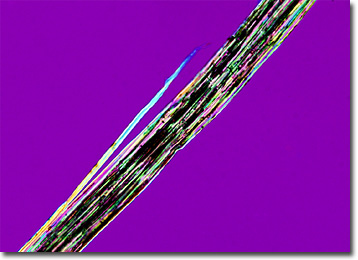Polarized Light Microscopy Digital Image Gallery
Kenaf Bast Fiber
Bast is a soft woody fiber that is heavily utilized in the manufacture of industrial textiles, ropes, and twines. The soft, flexible material is derived from the stems of various flowering plants known as dicotyledons.

View a second image of a Kenaf Bast Fiber
Kenaf is among the most widely utilized of the bast fibers. The material is produced by the plant of the same name, which is a member of the mallow family Malvaceae and is sometimes alternatively known as Guinea hemp. Though it grows naturally across the continent of Africa, the kenaf plant was not introduced to Europe until the late 1700s, where it did not gain wide use until World War II. The increase in the popularity of the material at this time of crisis was closely associated to shortages of other, more highly valued, materials, such as jute. Best grown in a warm, moist climate, today the world’s leading producers of kenaf are China, Thailand, and India.
A relative of cotton and okra, kenaf grows at a rapid pace, attaining heights as great as 14 feet in a single season. The stems of the plant are comprised of two different fibers, both of which are exploited commercially. An inner fiber, commonly referred to as the core, is woody, exhibiting coarseness and other properties similar to the fibers of hardwood trees. This material is heavily utilized in a wide array of paper products, as well as in particleboard. The fiber described as bast, however, is much softer and more flexible than the core it surrounds, making it a better-suited and more popular choice for many textiles and cordages.
